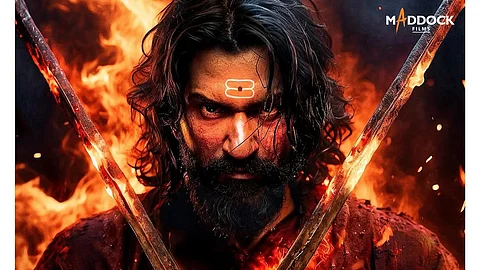
- Destinations
- Experiences
- Stay
- What's new
- Celebrating People
- Responsible Tourism
- CampaignsCampaigns
- SubscribeSubscribe
- Buy Now

The film "Chhaava," directed by Laxman Utekar and starring Vicky Kaushal, just released and has been reportedly performing well at the box office. The movie is a period drama based on the life of Maratha Chhatrapati Sambhaji Maharaj, adapted from a Marathi novel by Shivaji Sawant. The film brings to the screen various locations and monuments, including Purandar Fort, the birthplace of Sambhaji Maharaj.
Perched majestically atop the Western Ghats, Purandar Fort is a site of rich historical and cultural legacy of Maharashtra. This architectural wonder, located about 50 kilometres southeast of Pune, is a must-visit for history enthusiasts. Outlook Traveller delves deeper into the history and architecture of the Purandar Fort, uncovering its rich history, strategic importance, and stunning views.
The history of Purandar Fort goes as far back as the Yadava Kingdom in the 11th century. Being a vital military stronghold for several empires, it has seen many power battles over the ages. To strengthen its defences, the fort received major fortifications during the Bahamani Sultanate in the 14th century. A sacrificial ceremony, meant to keep the fort safe from invasion, is proof of the extent to which monarchs went to defend this fortress.
The Maratha Empire elevated the fort's status. One of the fort's earliest triumphs was the conquest of Purandar in 1649 by a youthful Chhatrapati Shivaji Maharaj. In 1665, the fort was under siege by Jai Singh II's Mughal army. Later, despite the heroic efforts of the Kingdom's commander, Murarbaji Deshpande, the fort collapsed. Thus, The Treat of Purandar was formed.
This agreement highlighted Purandar Fort's strategic significance—it required Shivaji give up 23 forts to the Mughals. Resilient as ever, the Marathas regained control of the area, and the fort, in 1670.
In Maratha history, Purandar Fort is particularly significant since it was the birthplace of Chhatrapati Sambhaji Maharaj in 1657. The setting of the fort—where Sambhaji later trained in warfare, administration, and statecraft— had an impact on his early years as the eldest son of Shivaji Maharaj. Sambhaji Maharaj ascended to the throne following Shivaji's death.
Purandar Fort, which has two separate levels—the higher "Ballekilla" and the lower "Machi"—is a wonder of mediaeval military design. A number of bastions dot the fort, each telling a story of a fight waged and won. A statue of Murarbaji Deshpande stands tall, in recognition of his steadfast resistance against the Mughals.
This lower portion included a hospital and military facilities, functioning as a busy cantonment area. The Machi's northern section has a massive gate with two sturdy towers on either side that opens into a level area that was formerly used for troops and administrative facilities.
The Ballekilla, or citadel, is the highest point of the fort. It is reached from the Machi by a steep stairway. The "Dilli Darwaja" (Delhi Gate), which dominates this area, is evidence of the fort's defensive might. The historic Kedareshwar temple, devoted to Hindu deity Shiva, is located within the Ballekilla and provides insight into the spiritual preferences of the fort's previous occupants.
Purandar Fort is a symbol of religious and cultural history that goes beyond its military significance. The main attraction for devotees and tourists is the Purandareshwar temple, which is devoted to the fort's patron deity. The Narayaneshwar temple, which is situated in the Narayanpur base village, is a calm haven for people in need of spiritual comfort. It is a prime example of Hemadpanthi architecture.
Purandar Fort has developed into a popular tourist spot among hiking, and history enthusiasts. The relatively difficult walk up to the fort rewards hikers with expansive views of the surrounding countryside. Instilling discipline and resilience in young cadets, the fort also acts as a training area for the National Cadet Corps (NCC). The fort's elevation and geography makes it a popular paragliding destination for adventure seekers, providing a unique viewpoint of the local environment.
Access: The fort is approximately 50 kilometers from Pune. Visitors can drive to the base village of Narayanpur, from where the trek to the fort commences.
Best Time: The monsoon season (June to September) adorns the region in lush greenery, enhancing the fort's scenic beauty. However, trekkers should exercise caution due to slippery paths. The post-monsoon and winter months (October to February) offer pleasant weather, ideal for exploration.
Permissions: As the fort is under the jurisdiction of the Indian government, certain areas might require permissions for access, especially for large groups or organised events. It's advisable to check with local authorities or tour operators prior to planning a visit.
Address: 7XJM+CM3, Purandar Rd, Gherapurandhar, Maharashtra 412205
Timings: 10 am to 3:30 pm
The monument is not ticketed.
